

Structure elucidation of multicolor emissive graphene quantum dots towards cell guidance
Jénnifer Gómez, Manuel Vázquez Sulleiro, Anna Dolečková, Naděžda Pizúrová, Jiřina Medalová, Antonín Bednařík, Jan Preisler, David Nečas, Lenka Zajíčková
Materials Chemistry Frontiers 6 (2022) 145-154
DOI: 10.1039/D1QM01126J
Graphene quantum dots (GQDs) can become excellent bioimaging tools when tuned to emit at larger wavelengths due to the minimal tissue absorbance and emission in this range. Tuning the GQDs structure can help, but understanding the chemical structure responsible for their properties remains challenging. Herein, we concluded on the structure of GQDs synthesized from glucose and ammonium hydroxide by fast microwave-assisted hydrothermal protocol. Remarkably, these GQDs exhibited emission from the NUV-Vis up to the NIR range. The structure and chemical composition was elucidated with advanced NMR techniques, such as dimensional nuclear magnetic resonance, combined with the traditional spectroscopies and electron microscopies. The graphitic core composed of pyrazines presented localized defects and lower rotation mobility compared with their edges that mainly were formed by hydroxyls, acids, and amines functional groups, which paved the way for the multicolor red-shift observed fluorescence emission. Confocal laser scanning microscopy revealed functioning cell imaging in a wide spectral range from bright purple to red fluorescence, confirming the uptake of GQDs by the cells without any observable toxicity. The non-cytotoxicity was further proved by the chemiluminescent cell viability adenosine triphosphate (ATP) assay. Combined with the tunable GQDs emission, it gives them the potential as bioimaging carriers starting a new phase for their use in vivo.
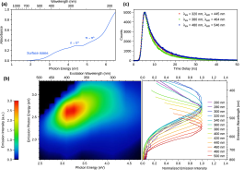
Exploring the Emission Pathways in Nitrogen-Doped Graphene Quantum Dots for Bioimaging
Jénnifer Gómez, Manuel Vázquez Sulleiro, Anna Dolečková, Naděžda Pizúrová, Jiřina Medalová, Rajarshi Roy, David Nečas, Lenka Zajíčková
Journal of Physical Chemistry C 125 (2021) 21044-21054
Graphene quantum dots (GQDs) with tunable fluorescence emission promise excellent bioapplication potential, especially in bioimaging. We report the synthesis of nitrogen-doped GQDs (N-GQDs) from glucose and ethylenediamine, cheap and safe chemicals, using a one-step and fast microwave-assisted hydrothermal method. Our N-GQDs exhibit fluorescence in the entire visible spectral region, which extends to near-ultraviolet and slightly to near-infrared. Since the origin of fluorescence and its relation to the structure and synthesis conditions are not yet fully understood, we also concentrated on the fluorescence mechanism explanation. Structural characterization with steady-state and time-resolved photoluminescence measurements indicated that band-to-band transitions, size effect, and different nitrogen and oxygen functional groups play a role in this multicolor emission. Remarkably, we found for the first time the evidence that directly relates a change in the N-GQD work function to the change in oxygen groups under UV irradiation via ultraviolet photoelectron spectroscopy. Thus, we confirmed that for λex ≲ 380 nm, photooxidation processes occurred, which led to chemical modification, thereby lowering the work function in the N-GQDs. The N-GQDs were proved to be highly biocompatible by a cell viability assay using vascular smooth muscle cells. Together with the wide spectral range emission observed in confocal fluorescence imaging, it demonstrated the potential of the N-GQDs for in vitro bioimaging applications.
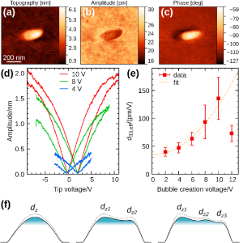
Evidence of flexoelectricity in graphene nanobubbles created by tip induced electric field
Rajarshi Roy, David Nečas, Lenka Zajíčková
Carbon 179 (2021) 677-682
DOI: 10.1016/j.carbon.2021.04.086
Strain engineering in graphene nanobubbles (GNB) have made significant progress in recent years opening new possibilities to observe quantum phenomena such as Newton’s ring oscillation and generation of pseudomagnetic field. Here, we demonstrated that controlled formation of graphene nanobubbles is possible on transferred graphene on standard SiO2/Si substrate by the application of external electric field through the tip of piezoelectric force microscope (PFM). We manipulated their dimensional attributes (height, area and volume) by varying tip ramp voltage and tip distance. Prominent out-of-plane piezo-response (flexoelectricity) was observed using PFM in the newly created nanobubbles due to the presence of non-uniform strain gradients in the nanobubbles. Moreover, we found quadratic dependence of the effective piezoelectric coefficient proportional to the increasing bubble creation ramp voltage. Our work motivates the exploration of flexoelectric properties and related applications with 2D nanobubbles in different substrates.
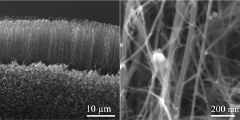
MEMS Carbon Nanotubes Field Emission Pressure Sensor With Simplified Design: Performance and Field Emission Properties Study
Jan Pekárek, Radimír Vrba, Jan Prášek, Ondřej Jašek, Petra Majzlíková, Jana Pekárková, Lenka Zajíčková
IEEE Sensors J. 15 (2015) 1430-1436
DOI: 10.1109/JSEN.2014.2363213
The pressure sensor application gained recently substantial interest in many fields of basic and applied research and applications. In this paper, microelectromechanical system (MEMS)-based pressure sensor contains nanostructured electrode consisting of carbon nanotube (CNT) array. CNTs are directly grown on such electrode by plasma-enhanced chemical vapor deposition method using microwave plasma torch at atmospheric pressure. This growth method enables us to use a simple electrode structure without need of buffer layer and timeconsuming lithography process. Combination of CNTs field emission and MEMS membrane mechanical properties make possible to enhance sensitivity of the sensor. Field emission properties of CNTs are measured by newly developed system enabling us precise measurement of expecting properties, such as dependence on diaphragm (upper electrode) distance, applied voltage, and stability of the sensor. Measured values are compared with a numerical modeling of the membrane system in CoventorWare software by finite-element method. We also suggest encapsulating the sensor using glass frit bonding because such method is more suitable for high vacuum requirements of the field emission operation.
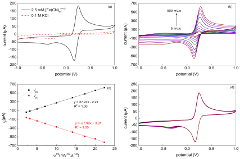
Sensing Properties of Multiwalled Carbon Nanotubes Grown in MW Plasma Torch: Electronic and Electrochemical Behavior, Gas Sensing, Field Emission, IR Absorption
Petra Majzlíková, Jiří Sedláček, Jan Prášek, Jan Pekárek, Vojtěch Svatoš, Alexander G. Bannov, Ondřej Jašek, Petr Synek, Marek Eliáš, Lenka Zajíčková, Jaromír Hubálek
Sensors 15 (2015) 2644-2661
DOI: 10.3390/s150202644
Vertically aligned multi-walled carbon nanotubes (VA-MWCNTs) with an average diameter below 80 nm and a thickness of the uniform VA-MWCNT layer of about 16 μm were grown in microwave plasma torch and tested for selected functional properties. IR absorption important for a construction of bolometers was studied by Fourier transform infrared spectroscopy. Basic electrochemical characterization was performed by cyclic voltammetry. Comparing the obtained results with the standard or MWCNT-modified screen-printed electrodes, the prepared VA-MWCNT electrodes indicated their high potential for the construction of electrochemical sensors. Resistive CNT gas sensor revealed a good sensitivity to ammonia taking into account room temperature operation. Field emission detected from CNTs was suitable for the pressure sensing application based on the measurement of emission current in the diode structure with bending diaphragm. The advantages of microwave plasma torch growth of CNTs, i.e., fast processing and versatility of the process, can be therefore fully exploited for the integration of surface-bound grown CNTs into various sensing structures.
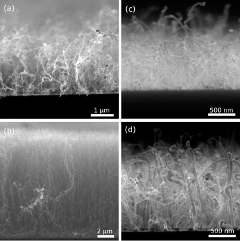
Atmospheric pressure barrier discharge at high temperature: Diagnostics and carbon nanotubes deposition
Marek Eliáš, Petr Kloc, Ondřej Jašek, Věra Mazánková, David Trunec, Radim Hrdý, Lenka Zajíčková
Journal of Applied Physics 117 (2015) 103301
DOI: 10.1063/1.4914062
Atmospheric pressure dielectric barrier discharge (DBD) in Ar/H2 gas feed with C2H2 or CH4 admixture was studied at room and high temperature of 680 °C by plasma diagnostics (electrical measurements, fast camera imaging, and optical emission spectroscopy). It was shown that filamentary DBD in pure Ar or Ar/H2 can be converted into homogeneous discharge by an acetylene admixture. Fast intensified charge-coupled device (ICCD) camera proved that this homogeneous discharge is an atmospheric pressure glow discharge (APGD) at room temperature whereas at high temperature the discharge mode switches at every half-period between APGD and atmospheric pressure Townsend discharge. The high temperature discharges (610–710 °C) in Ar/H2/C2H2 and Ar/H2/CH4 were also investigated with respect to a surface bound deposition of carbon nanotubes using 5 nm thick iron layer as a catalyst. CNTs were deposited without any dedicated catalyst pretreatment phase. The quality of CNTs, namely, their density, vertical alignment, and width of the diameter distribution, was better for the C2H2 gas feed and higher temperatures.